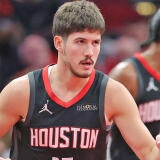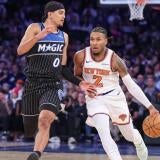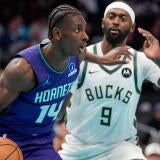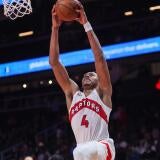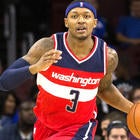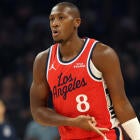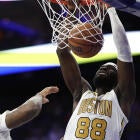Fantasy basketball: What did the preseason tell us?
Before the regular season starts, Chris Towers takes one last look back at the NBA preseason to see if we can learn anything.

The preseason can't tell us anything.
That's the typical response anytime someone tries to cite preseason production in any sport, not just the NBA. The sample size is too small, the games don't matter and a lot of the teams are experimenting with lineups and roles that will vanish as soon as the actual season starts.
Still, that doesn't mean we should just dispose of the preseason entirely. There are still hints of how teams plan to use players hidden in their preseason numbers, and we can at least start to answer some of our biggest questions for the season. Maybe these answers will turn out to be completely useless by this time next week, but it's all we have to go on right now.
With the regular season set to tip off Tuesday evening, here are the biggest questions I had heading into the preseason and the potential answers the exhibition schedule provided.
How did the Thunder use Kevin Durant and Russell Westbrook?
Russell Westbrook put together one of the most impressive statistical seasons in NBA history in 2014-15, but his Fantasy appeal came with a gigantic boulder of salt, because he did it without Kevin Durant around. With Durant (and eventually Serge Ibaka) out with injuries, Westbrook had to dominate the ball to an almost comical degree, and that led to his video game numbers. The big question heading into this season is how does new coach Billy Donovan plan to utilize his two superstars. Would Westbrook's ascendance last season lead to him taking on the lead role, or would Durant still be the top dog?
That question ignores a couple of key factors, of course, and the preseason numbers show that. Durant led the Thunder in scoring, but Westbrook took the most shots and dominated the ball, dishing out 8.4 assists in just 25.1 minutes per game. Because of course he did. Westbrook is the point guard, much to the chagrin of stodgy traditionalists. Of course he has the ball in his hands more than Durant, even if Durant is undoubtedly the better player. Durant is the tip of the spear, but Westbrook is the one that needs to chuck that spear into opponent's hearts.
Having said that, I would still expect Durant to take more than the 17.1 shots per 36 minutes he averaged in the preseason. Billy Donovan is a smart guy who knows that there is no more dangerous weapon in the NBA than Kevin Durant getting 20 field-goal attempts per game. I'm not worried about this duo coexisting, and with both topping 50 percent shooting in the preseason, I wouldn't say there is much reason to be concerned in any way. If both stay healthy, they might both finish in the top five for Fantasy.
How did the revamped Pistons offense help Andre Drummond and Reggie Jackson?
The Jackson-Drummond pick and roll has the potential to devastate the league, and they showed flashes of that late last season, when Greg Monroe's injury opened up the floor for the two to run roughshod over opposing defenses. The key was that, with Jackson's shaky jumper and Drummond's range extending only as far as he can throw a ball directly into the hoop, the Pistons can't really afford to play this duo with another non-shooting threat.
The acquisitions of Ersan Ilyasova and Marcus Morris as shooting power forwards should give them the room they need, and that's exactly what we saw in the preseason. Drummond and Jackson led the team in scoring, respectively, and their per-minute numbers were through the roof. Drummond averaged 19.4 points and 15.1 rebounds per 36 minutes in his eight games, while Jackson managed 18.7 points and 8.8 assists per 36. With stretch-fours Morris, Ilyasova and Anthony Tolliver combining for 67.8 minutes per game, plus the addition of Stanley Johnson and continued development of Kentavious Caldwell-Pope, there should be plenty of shooting surrounding this dangerous duo.
Did Bradley Beal commit to changing his game?
One of my favorite trends of the offseason has been the Wizards' seemingly committing to a modern NBA offense. I've been pretty vocal in my criticism of Randy Wittman's approach to scoring, specifically with regards to its adverse affect on Beal's game. The Wizards have spoken loudly about their intentions to take more 3-pointers, at the expense of those inefficient, offense-ruining mid-range jumpers, and Beal has followed suit. The early returns are promising, too.
Last season, 30.4 percent of Beal's shots were 3-pointers, compared to 37.1 percent from mid-range and 22.7 in the restricted area, according to stats.NBA.com. In six preseason games, 36.4 percent of Beal's shots were 3-pointers, and he cut his rate of mid-range attempts to 27.3 percent -- identical to his rate in the restricted area. Those aren't huge changes, but they represent a move in the right direction, toward a more efficient, more dangerous Bradley Beal. It is no surprise his scoring was up to 23.5 points per-36 minutes in the preseason.
There's still star potential here and small changes are all he needs to unlock it.
How did the Paul George as power forward experiment work?
This was a pretty resounding success. Despite the 25-year-old's protestations early on, he absolutely destroyed opposing defenses, scoring 18.7 points per game in just 24.4 minutes. Extrapolate that out to a 36-minute pace and George averaged 27.6 points to go with 9.3 rebounds and 2.4 assists. George may not be totally thrilled about the idea of banging with opposing big men for 40 minutes per night, but he is going to be an absolute terror for them to cover on the other end. He is an obvious injury risk, but George might have top-five Fantasy potential in the second round, and nothing we saw in the preseason should make us doubt that.
How did the rebuilt Trail Blazers play?
"Rebuilt" is one word for what happened to the Blazers this offseason. That's the optimistic view, anyways. It's a neat little euphemism for "lost 80 percent of arguably the best starting lineup in the league. We know Damian Lillard is still the starter at the point, and he played exactly how we expected in the preseason, taking 21 shots per game in 31.3 minutes. Efficiency may be an issue, but he's a dark horse candidate to lead the league in scoring, based on the team around him.
C.J. McCollum predictably took on the secondary role, finishing second on the team in minutes per game (30.9) and points (18.3), while also tossing in 4.4 assists per game. It wouldn't exactly stun me if he came close to those numbers in the regular season. Beyond that, this team enters the season with as many questions as anyone, and the preseason didn't do a whole lot to answer them.
Al-Farouq Aminu was third on the team in minutes per game, and Allen Crabbe was fourth. The fact Aminu missed four games likely boosted Crabbe's standing here. Aminu should see consistent playing time this season, but the rest of the frontcourt is where things get interesting. Meyers Leonard (24.7 MPG), Noah Vonleh (22.6), Ed Davis (22.4) and Mason Plumlee (21.3) all played between 21 and 25 minutes, with Plumlee playing the least probably the biggest surprised. Given his pick-and-roll abilities, you would think he would be a big part of the offense, and I would guess he will ultimately emerge as the team's most-used big man. However, there are a lot of bodies here, and the preseason didn't answer enough questions to make me really change my opinion.

